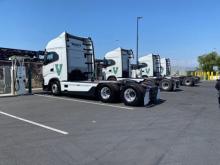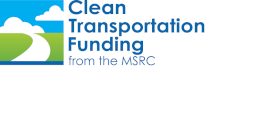
On July 24, the MSRC was on-hand to celebrate WattEV’s grand opening of the largest publicly accessible heavy-duty truck charging site in the nation, funded, in part, with Clean Transportation Funding from the MSRC. Thanks to a unique partnership between the MSRC and the Southern California Association of Governments (SCAG), WattEV was awarded nearly $3 million through SCAG’s Last Mile Freight Program to support “last mile” technologies to help those in the goods movement industry invest in cleaner trucks and infrastructure.
The site is approximately one-and-a-half acres and has 13 CCS (combined charging system) 360 kW chargers, providing the capacity to charge 26 trucks at one time. WattEV plans to have megawatt charging in future phases of the project that will enable the facility to house pass-through lanes for opportunity chargers and reduce charging times to 30-45 minutes from the 2-3 hours it takes today.
Congressmember and former Long Beach Mayor Robert Garcia kicked-off the event by expressing his enthusiasm. “The future of not just our ports, but our country is electric,” he said. “I’m happy to be a part of ushering in this electric future that we are all so excited about and that we owe to our local communities that are so impacted by air pollution.”
California Energy Commissioner Patricia Monahan said she has been involved in transportation for most of her career and that this is the moment she has been waiting for. “Now is the time that zero-emission transportation is completely within our grasp. It has taken entrepreneurial leadership like what we’re seeing with WattEV to bring that to fruition,” she explained. “The fact that we are here today celebrating this public access site shows how much progress we are seeing and how much increased investment we are seeing in the space of delivering infrastructure for zero-emission vehicles.”

Sharon Weissman, President of the Long Beach Board of Harbor Commissioners, acknowledged that WattEV is helping the Port achieve its goal of having 100 heavy-duty truck charging stations in operation by 2026. “WattEV is stepping up in this trailblazing role and supporting the Port’s Clean Air Action Plan of 100 percent zero-emission drayage operations by 2035,” she noted. “WattEV’s innovative ‘truck-as-a-service’ business model also addresses one of the major equity challenges of getting to zero-emission drayage by providing small fleets and single truck operators an all-in-one package of a full-service lease and access to charging at a cost that is comparable with operating a diesel truck.”
California Air Resources Board Chair Liane Randolph remarked that this zero-emission depot is a major milestone in the zero-emission future that California is building. She said that the freight sector produces about half of all air pollution in California and disproportionately impacts frontline communities. “Thanks to the ambition of Governor Newsom, the Biden Administration, tireless advocacy by impacted communities, and the vision of private and public sector partners like WattEV, trucking and freight transport are headed for a cleaner, healthier future.”
Salim Youssefzadeh, CEO and Founder of WattEV, said that a tremendous amount of work and collaboration amongst the project partners went into getting the depot operational in just 14 months. He thanked all the partners who contributed to the project, including the MSRC/SCAG partnership, who were tremendous supporters to make WattEV’s vision a reality with grants and incentives.
The MSRC invested more than $16 million in SCAG’s Last Mile Program, as part of the MSRC’s larger efforts to help reduce harmful heavy-duty truck emissions from the goods movement industry.
